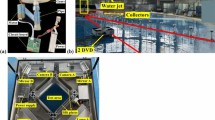Summary
A method for evaluating the water application rate (WAR) and uniformity coefficient (Cu) of overlapping irrigation sprinklers is given for realistic field conditions which includes wind drift of the sprinkler spray. The method requires as input — the geometry of the sprinkler arrangement, trajectories of water drops from the sprinkler nozzle as calculated by the equations of motion and the WAR distribution (discharge) profile of a single sprinkler experimentally observed under windless conditions. Wind direction with respect to the main sprinkler line is shown to have a small effect on Cu and is assumed to be parallel to the main line. Results show that the effect of wind drift of sprinkler spray on Cu can be neglected for wind velocities less than 1 ms−1 (Fig. 8). Analysis of simulated discharge profiles (Table 1) shows that the maximum value of the uniformity coefficient was obtained with triangular sprinkler discharge profiles at low values of spacing, changing to trapezoidal profiles as the spacing increases (Figs. 8 and 9). The effect of nozzle pressure on WAR was evaluated for the pressure range between 294 and 490 kPa and an optimum layout of overlapping sprinklers, designed to minimize the effect of wind drift and nozzle pressure on the uniformity of WAR distribution, is presented.
Similar content being viewed by others
Abbreviations
- C D :
-
air drag coefficient of water drop
- Cu :
-
uniformity coefficient
- D :
-
diameter of water drop
- d k :
-
reference k-th water drop
- Δλ:
-
incremental scanning distance at a certain size matrix
- g :
-
acceleration of gravity
- h pm :
-
mean value of water application rate (mean value of WAR)
- h (x, y):
-
WAR at points P (x, y)
- h o (k, n):
-
WAR at points P o (k, n)
- h p (l, m):
-
WAR at cross points of a certain size matrix covering the unit area for calculation of Cu
- i :
-
row index number (see Fig. 3)
- j :
-
column index number (see Fig. 3)
- K :
-
Kàrmán's constant
- k :
-
index number of water drop, d k
- L :
-
number of scanning points along main line
- l :
-
index number of scanning point along main line
- M :
-
number of scanning points along the line perpendicular to main line
- m :
-
index number of scanning point along the line perpendicular to main line
References
Christiansen JE (1942) Irrigation by sprinkling. Calif Agric Exp Stn Bull 670:1
Lyles L (1977) Wind erosion: Processes and effect on soil productivity. Trans ASAE 20:880
Okamura S (1968) Theoretical study on sprinkler sprays (I) ∼ (III). Trans JSIDRE 26:49
Okamura S, Nakanishi K (1969) Theoretical study on sprinkler sprays (IV). Trans JSIDRE 28:35
Okamura S, Nakanishi K (1971) Distribution of water depth from overlapping sprinklers. Trans JSIDRE 38:51
Author information
Authors and Affiliations
Rights and permissions
About this article
Cite this article
Fukui, Y., Nakanishi, K. & Okamura, S. Computer evaluation of sprinkler irrigation uniformity. Irrig Sci 2, 23–32 (1980). https://doi.org/10.1007/BF00285427
Received:
Issue Date:
DOI: https://doi.org/10.1007/BF00285427




